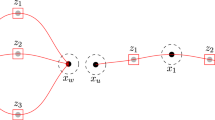Abstract
We study complexity of several problems related to the Transverse field Ising Model (TIM). First, we consider the problem of estimating the ground state energy known as the Local Hamiltonian Problem (LHP). It is shown that the LHP for TIM on degree-3 graphs is equivalent modulo polynomial reductions to the LHP for general k-local ‘stoquastic’ Hamiltonians with any constant \({k \ge 2}\). This result implies that estimating the ground state energy of TIM on degree-3 graphs is a complete problem for the complexity class \({\mathsf{StoqMA}}\) —an extension of the classical class \({\mathsf{MA}}\). As a corollary, we complete the complexity classification of 2-local Hamiltonians with a fixed set of interactions proposed recently by Cubitt and Montanaro. Secondly, we study quantum annealing algorithms for finding ground states of classical spin Hamiltonians associated with hard optimization problems. We prove that the quantum annealing with TIM Hamiltonians is equivalent modulo polynomial reductions to the quantum annealing with a certain subclass of k-local stoquastic Hamiltonians. This subclass includes all Hamiltonians representable as a sum of a k-local diagonal Hamiltonian and a 2-local stoquastic Hamiltonian.
Similar content being viewed by others
References
Kitaev A., Shen A., Vyalyi M.: Classsical and Quantum Computation. American Mathematical Society, Providence (2002)
Oliveira R., Terhal B.M.: The complexity of quantum spin systems on a two-dimensional square lattice. Quant. Inf. Comput. 8(10), 900–924 (2008)
Aharonov D., Gottesman D., Irani S., Kempe J.: The power of quantum systems on a line. Commun. Math. Phys. 287(1), 41–65 (2009)
Hallgren S., Nagaj D., Narayanaswami S.: The local Hamiltonian problem on a line with eight states is QMA-complete. Quant. Inf. Comput. 13(9–10), 721–750 (2013)
Schuch N., Verstraete F.: Computational complexity of interacting electrons and fundamental limitations of density functional theory. Nat. Phys. 5(10), 732–735 (2009)
Childs, A.M., Gosset, D., Webb, Z.: The Bose–Hubbard model is QMA-complete. In: Proceedings of the 41st International Colloqium on Automata, Languages, and Programming (ICALP), pp. 308–319 (2014)
Cubitt T., Montanaro A.: Complexity classification of local Hamiltonian problems. SIAM J. Comput. 45(2), 268–316 (2016)
Bravyi S., DiVincenzo D., Oliveira R., Terhal B.: The complexity of stoquastic local Hamiltonian problems. Quant. Inf. Comput. 8(5), 0361–0385 (2008)
Suzuki M., Miyashita S., Kuroda A.: Monte Carlo simulation of quantum spin systems. I. Prog. Theor. Phys. 58(5), 1377–1387 (1977)
Prokof’ev N., Svistunov B., Tupitsyn I.: Exact quantum Monte Carlo process for the statistics of discrete systems. Pis’ma v Zh. Eks. Teor. Fiz. 64(12), 911–916 (1996)
Sandvik A.W., Kurkijärvi J.: Quantum Monte Carlo simulation method for spin systems. Phys. Rev. B 43(7), 5950 (1991)
Trivedi N., Ceperley D.M.: Green-function Monte Carlo study of quantum antiferromagnets. Phys. Rev. B 40(4), 2737 (1989)
Bravyi, S.: Monte Carlo simulation of stoquastic Hamiltonians. arXiv:1402.2295 (arXiv preprint) (2014)
Pfeuty P.: The one-dimensional Ising model with a transverse field. Ann. Phys. 57(1), 79–90 (1970)
Sachdev S.: Quantum Phase Transitions. Cambridge University Press, Cambridge (2007)
Kopeć T.K., Usadel K.D., Büttner G.: Instabilities in the quantum Sherrington–Kirkpatrick Ising spin glass in transverse and longitudinal fields. Phys. Rev. B 39(16), 12418 (1989)
Laumann C., Scardicchio A., Sondhi S.L.: Cavity method for quantum spin glasses on the Bethe lattice. Phys. Rev. B 78(13), 134424 (2008)
Farhi, E., Goldstone, J., Gutmann, S., Sipser, M.: Quantum computation by adiabatic evolution. arXiv:quant-ph/0001106 (arXiv preprint) (2000)
Boixo S., Rønnow T., Isakov S., Wang Z., Wecker D., Lidar D., Martinis J., Troyer M.: Evidence for quantum annealing with more than one hundred qubits. Nat. Phys. 10(3), 218–224 (2014)
Rønnow T.F., Wang Z., Job J., Boixo S., Isakov S., Wecker D., Martinis J., Lidar D., Troyer M.: Defining and detecting quantum speedup. Science 345, 420 (2014)
Shin, S.W., Smith, G., Smolin, J., Vazirani, U.: How “quantum” is the D-wave machine? arXiv:1401.7087 (arXiv preprint) (2014)
Kempe J., Kitaev A., Regev O.: The complexity of the local Hamiltonian problem. SIAM J. Comput. 35(5), 1070–1097 (2006)
Bravyi, S., Bessen, A.J., Terhal, B.M.: Merlin–Arthur games and stoquastic complexity. arXiv:quant-ph/0611021 (arXiv preprint) (2006)
Farhi E., Goldstone J., Gutmann S., Lapan J., Lundgren A., Preda D.: A quantum adiabatic evolution algorithm applied to random instances of an NP-complete problem. Science 292(5516), 472–475 (2001)
Jansen S., Ruskai M.-B., Seiler R.: Bounds for the adiabatic approximation with applications to quantum computation. J. Math. Phys. 48, 102111 (2007)
Schrieffer J.R., Wolff P.A.: Relation between the Anderson and Kondo hamiltonians. Phys. Rev. 149(2), 491 (1966)
Bravyi S., DiVincenzo D.P., Loss D., Terhal B.M.: Quantum simulation of many-body Hamiltonians using perturbation theory with bounded-strength interactions. Phys. Rev. Lett. 101(7), 070503 (2008)
Bravyi S., DiVincenzo D.P., Loss D.: Schrieffer–Wolff transformation for quantum many-body systems. Ann. Phys. 326(10), 2793–2826 (2011)
von Gehlen G., Iorgov N., Pakuliak S., Shadura V., Tykhyy Yu.: Form-factors in the Baxter–Bazhanov–Stroganov model II: Ising model on the finite lattice. J. Phys. A Math. Theor. 41(9), 095003 (2008)
Isakov S., Hastings M.B., Melko R.: Topological entanglement entropy of a Bose–Hubbard spin liquid. Nat. Phys. 7(10), 772–775 (2011)
Isakov S., Melko R., Hastings M.B.: Universal signatures of fractionalized quantum critical points. Science 335(6065), 193–195 (2012)
Cao Y., Nagaj D.: Perturbative gadgets without strong interactions. Quant. Inf. Comput. 15(13, 14), 1197–1222 (2015)
Hastings M.B.: Obstructions to classically simulating the quantum adiabatic algorithm. Quant. Inf. Comput. 13(11–12), 1038–1076 (2013)
Fendley P.: Free parafermions. J. Phys. A 47, 075001 (2014)
Author information
Authors and Affiliations
Corresponding author
Additional information
Communicated by M. M. Wolf
Rights and permissions
About this article
Cite this article
Bravyi, S., Hastings, M. On Complexity of the Quantum Ising Model. Commun. Math. Phys. 349, 1–45 (2017). https://doi.org/10.1007/s00220-016-2787-4
Received:
Accepted:
Published:
Issue Date:
DOI: https://doi.org/10.1007/s00220-016-2787-4




